How to Use Homeschool Bible Curriculum for All Learning Styles
How to Use Homeschool Bible Curriculum for All Learning Styles
I have to admit I never really thought much about homeschool Bible curriculum as it relates to my children’s learning styles until I found The Word in Motion! This curriculum is meant for children from kindergarten through about 8th grade. It’s full of all kinds of ways for children of all learning styles to learn about the Bible!

Perfect for Multiple Ages
While this curriculum is geared toward children from kindergarten through about 8th grade, you can easily use it with older children too–especially if you have both older and younger children in your home.
Honestly, I love to see parents and older siblings getting involved in using homeschool Bible curriculum like this with the younger children because all of us typically learn best when a variety of learning styles are addressed. And when a subject is broken down in a simple way for younger kids, it makes it easier for people of all ages to learn and understand!
I desperately wish The Word in Motion had been available when my children were all young! I help with the children’s program at my church, though, and I have a young niece and nephew that I spend a lot of time with, so I’m excited to use it with them!
Note: This is a sponsored post, and I received this curriculum for the purpose of writing this review. My promise to you, though, is that I will always give an honest review. We want our readers to be able to trust that any curriculum or service you see on our site is one we believe in and would use (or did use) with our own children in our own homeschools.
What’s Included and How to Use It
Resources Included in Each Set
You may choose from two sets, and there are two versions of each set.
The Word in Motion Old Testament Advantage Set includes the hardcover textbook, spiral-bound softcover notebooking journal, streaming video lessons, and an audio download of the lessons being read. (shown below)
The Word in Motion New Testament Advantage Set includes the same resources except (of course) these are for the New Testament instead of the Old Testament. (shown below)
You may also choose the Old Testament Basic Set or the New Testament Basic Set. The only difference is that the audio downloads of the lessons being read are not included.
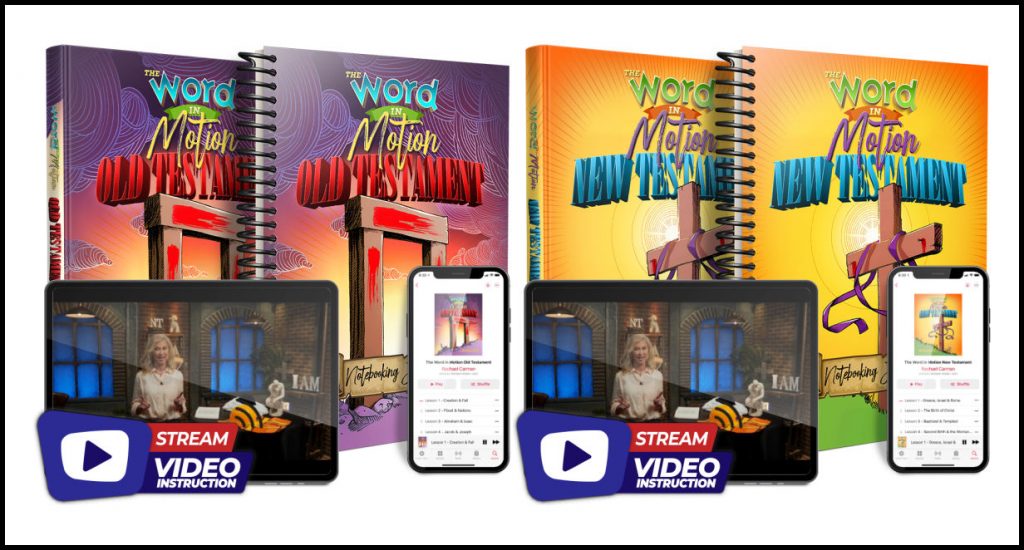
How to Plan and Schedule Your Study
4 Days a Week for 30 Weeks
The curriculum is already planned out and scheduled for you! The included schedule is for 4 days a week, and there are 30 weeks’ worth of lessons. Many states require 180 days (36 weeks) of instruction each year, so this schedule gives you a little flexibility and still allows you to finish either the Old or New Testament in one school year.
There is a lesson plan included in the textbook, and there is a more detailed lesson plan available online at the Book Extras website. It explains which specific pages to read each day and tells you the corresponding activities in the notebooking journal to make it super easy. (This is a good place to mention that you’ll want a separate notebooking journal for each child who’s doing the study.)
Start Your Day on the Right Foot with Your Family!
During my children’s growing-up years, we started each school day by reading the Bible, praying together, and then reading a just-for-fun book together. Similarly, the author suggests that you (Mom or Dad) read each day’s lesson to your children. Then you should all discuss the lesson together and do the notebooking journal activities. You may want to pray together too (or encourage your children to take turns praying). A prayer is included with each lesson, so you can pray the included prayer or pray your own. Or you can do both!
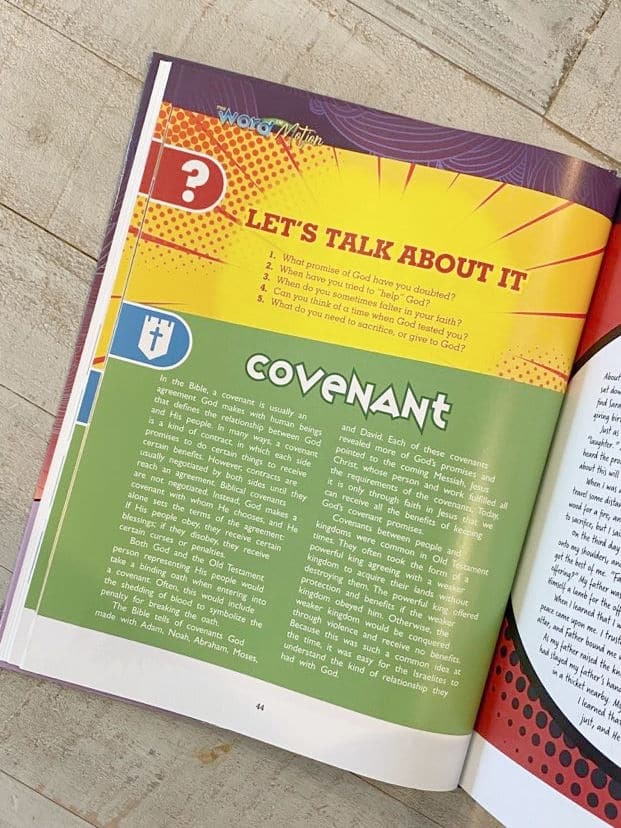
Beginning your day with your Bible study is a great way to show your children that God’s Word is a priority for your family. Also, I noticed with my own children that our days went better when we took time to read and study the Bible and pray before starting with our school work and activities for the day.
How It Works for Different Learning Styles
Kinesthetic Learners (Kids Who Need Action)
You won’t be surprised to learn that The Word in Motion gives learners all kinds of ways to be active during the learning process! Even as an adult, I enjoy learning more and retain more of what I learn when I can learn in a hands-on way.
I’m the kind of person who has to watch someone else do something first, but then I have to do it for myself if I’m going to remember it later. That’s why I love that this homeschool Bible curriculum includes lots of ways to do things! I’ll talk more about that below where I explain how lessons are done each day and week.
Motions
Your children will have the opportunity to learn motions each week. These motions represent events, people, etc., and help children (and parents!) remember what that week’s lesson was all about. (Older kids might enjoy doing the motions with younger siblings as an example.)
Even very young children who aren’t yet school-age will learn the motions along with older siblings. They may not understand everything they’re hearing and learning, but it will make sense to them as they get older. And you’ll be surprised how much they will understand and remember! And besides all that, they’ll be learning that Bible time is something they look forward to doing.
Notes
Note-taking is another way for kids to be active. (It’s also great for visual learners.) When I was in elementary school all the way through college, I studied by taking notes on the material I needed to learn and then rewriting those notes over and over. I’m not suggesting that you should have your kids do the same, but it is very possible that some of your hands-on learners will actually enjoy taking notes (and maybe even rewriting them) as a way of remembering what they’ve learned! This is also a good time for your kids to see the usefulness of learning to take notes if it’s something they haven’t done before.
Coloring, Drawing, Sequencing, Answering Questions, and Creating and Using Flash Cards
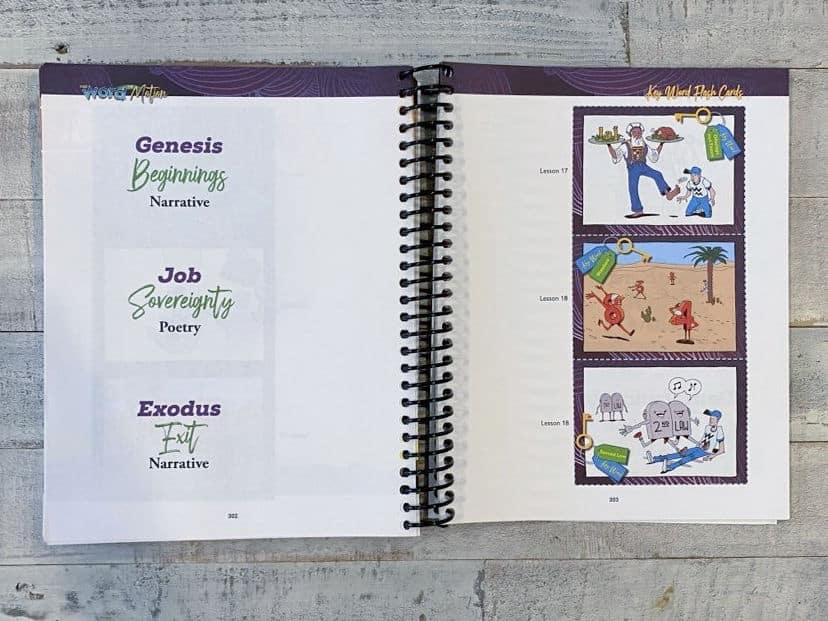
Remember when I said there were lots of hands-on things to do with this homeschool Bible curriculum? I meant it! Your children will have chances to color, draw, put events in sequence, answer questions, cut out and use flashcards, and more! All of these are active ways to take in and remember important information from each lesson.
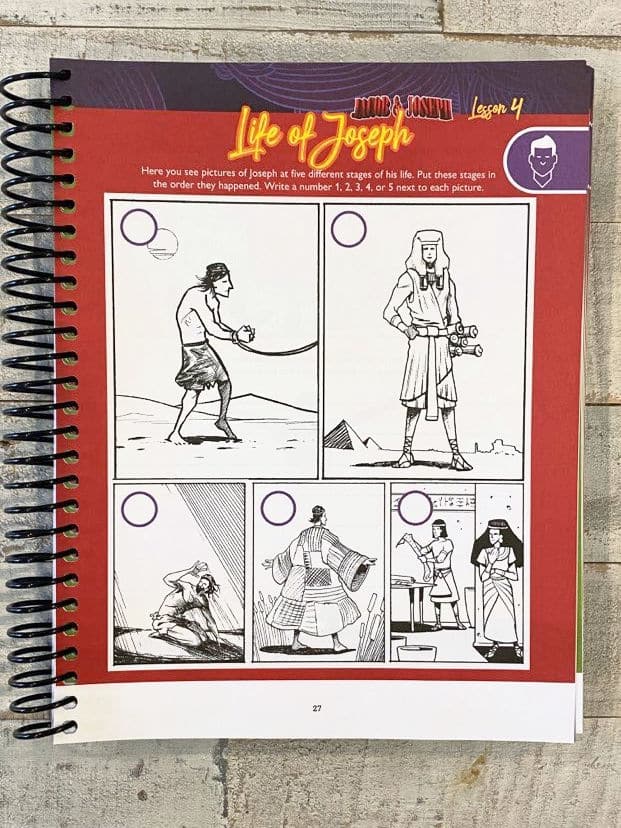
Auditory Learners
Videos
What about auditory learners? They’re covered too! Each lesson includes a video to watch together before doing that day’s reading. (This is also great for visual learners.) The video includes a brief introduction to that day’s lesson and a demonstration of one or more of the motions that correspond with the lesson (or previous lessons).
Memory Verses
Memory verses are provided each week. The lesson plans suggest reading the memory verse each day, but I also suggest practicing the verse (for example) at snack time or lunchtime or some other set time during the day. Or you could have your kids practice (or recite) it each week for a grandparent or friend.
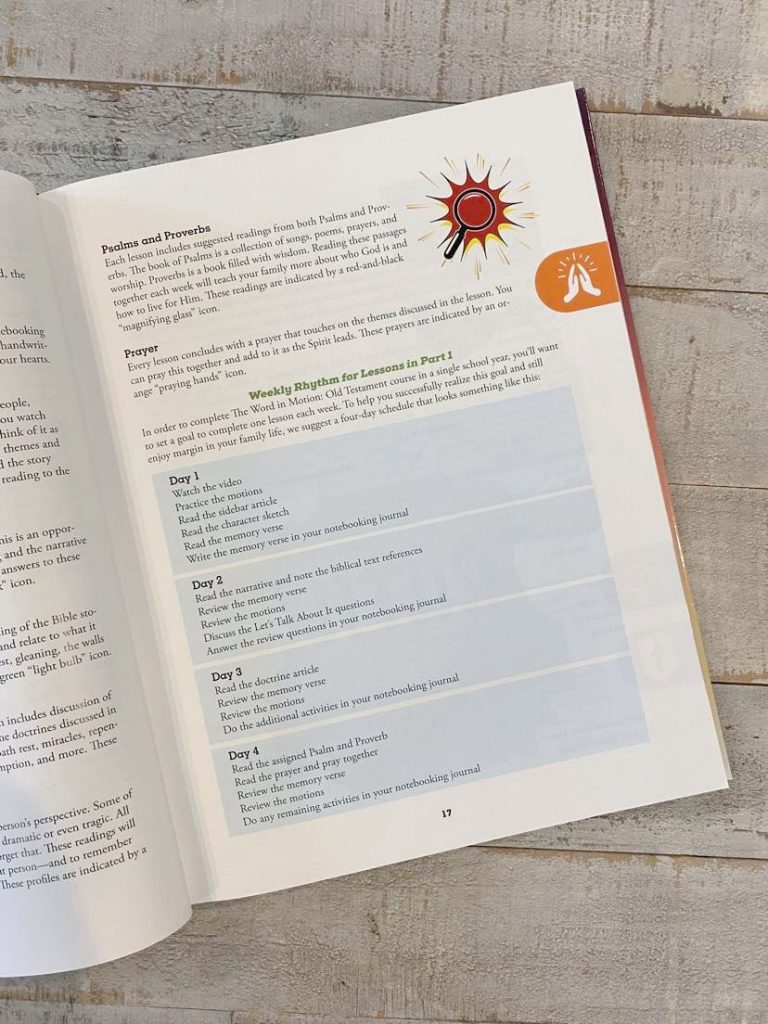
If you have very young children, they’ll learn it quickly by hearing you or an older sibling read it several times each day. If you have older children who can read it for themselves, have them write it on a notecard or even make a video of themselves saying the verse to watch/listen to a few times during the day.
Be sure to have them practice the previous weeks’ memory verses each week too!
NOTE: If you’d rather use a version other than the one included in this curriculum, you can do that too.
MP3/Audiobook Download
Another great way for auditory learners to take in information is by using the MP3 download/audiobook that is available for the Old Testament and the New Testament. Ideally you, the parent, will read the lesson with the family each day. It is possible, though, that there could be days when that’s not possible. In that case, the children could listen to the downloaded audiobook instead.
It’s also a good idea to have the children listen (individually or all together) to the audiobook version at a later time during the day to reinforce what you read and discussed earlier in the day. Just as I mentioned how I personally learn from seeing and writing my notes over and over, auditory learners learn by hearing information over and over, so this is a great option for them!
They might even download the audio lessons and listen to them while doing chores like unloading the dishwasher or sweeping the floor, etc. Those are quiet chores (and can be boring!), so listening to that day’s lesson again while doing those tasks is a great way to help kids listen, learn, and remember even more.
Visual Learners
Vidoes
Videos are not only great for auditory learners, but they’re also perfect for visual learners! And since each lesson begins with a video, it will help grab your visual learner’s attention right from the start of each day’s lesson. (You can see the author, Rachael Carman, demonstrating the motions from a lesson in the screenshot of one of the vidoes below.)
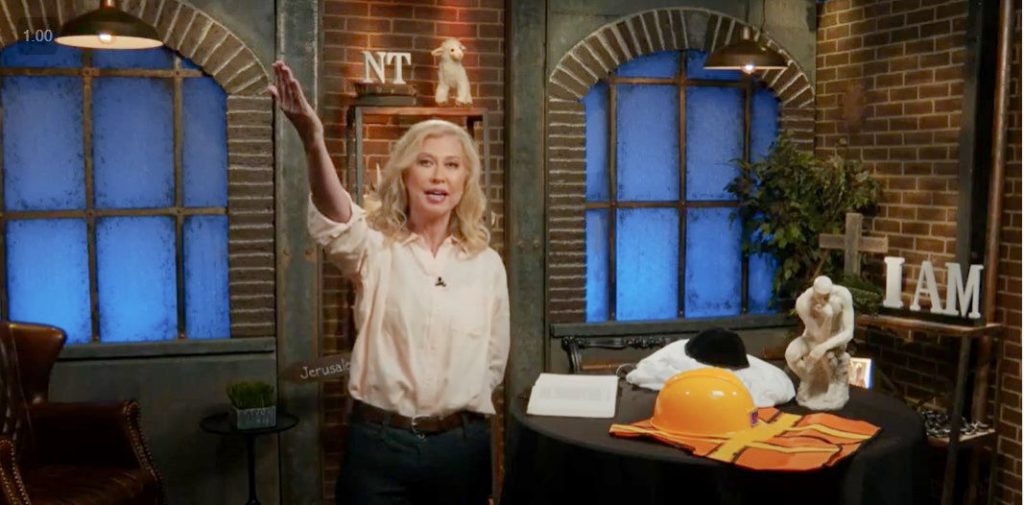
Motions
If you haven’t thought about it before, motions are a good way for visual learners (as well as kinesthetic learners) to remember each day’s lesson! Because the motions represent key people and events from the lesson, they will help give your visual learner a way to “see” what happened in each lesson.
Be sure to practice the previous weeks’ motions (in order) each week to help your children remember everything they’ve learned so far!
Colorful Curriculum
As you can see from the photos I’ve included, this is a beautiful, colorful homeschool Bible curriculum! There is nothing bland or boring about this textbook or about the notebooking journal.
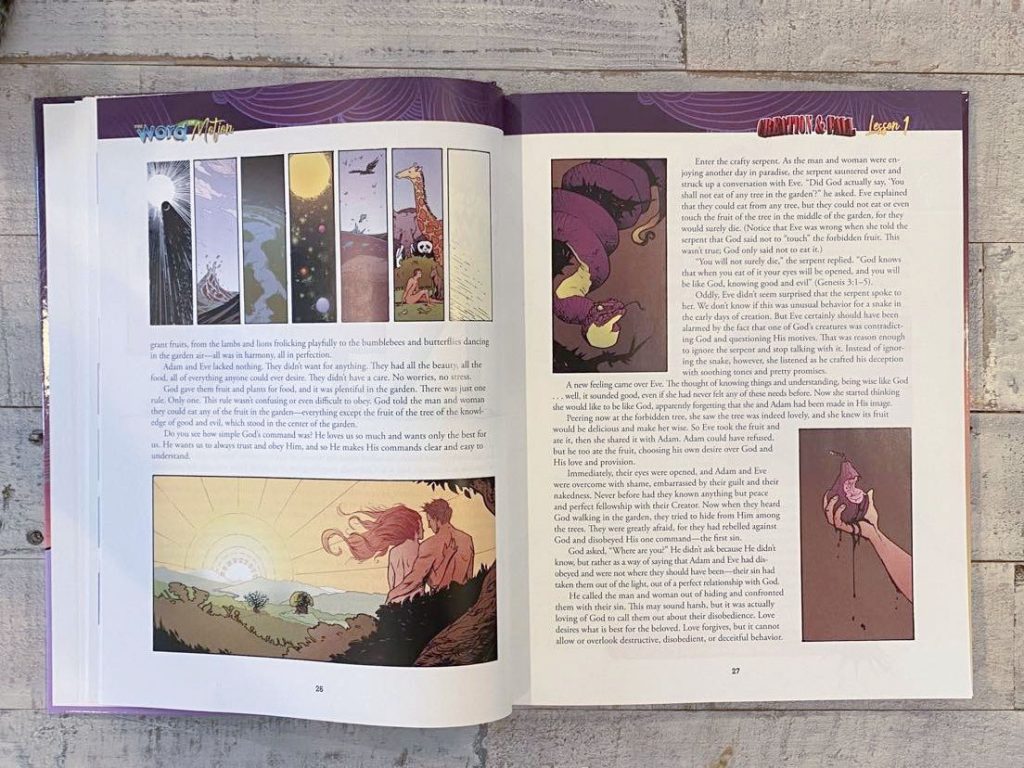
How It Works (Planning and Using the Curriculum)
Lessons
Both the Old Testament set and the New Testament set include 30 lessons. Every lesson is open-and-go. In other words, you don’t need to spend time preparing ahead of time!
I know most homeschooling parents are willing to put in the time needed to prepare lessons ahead of time. It’s so nice, though, to know there’s no pressure to make time to do that with this homeschool Bible curriculum!
Two Sections Per Set (OT and NT)
Chronological Order (The First Section)
The first section of the book (lessons 1-15) goes through the OT or the NT in chronological order. That section gives the family an overview of what happened and the order in which it happened.
I love that each set begins with sharing the overall story in chronological order! When I was a child (and even into my adult years), the Bible sometimes seemed like a mixed-up collection of stories and events. It was sometimes hard to see the connections between people and events.
That’s why I’m particularly excited that this curriculum begins by guiding your family in seeing the order of events, the order in which people lived, and how one event connects to another.
Book by Book (The Second Section)
The second section is the book-by-book part (lessons 16-30). This is exactly what it sounds like! You’ll find more specific information about each book of the Bible.
Video
Just like the first 15 lessons, each of these lessons begins with a video. First is the introduction to the book. Then you’ll learn a key word and a motion. After that, comes Jesus! (Here, you’ll learn how Jesus is found in the book covered in that week’s lesson.)
After the video, you’ll read the textbook and work in the notebooking journal. Here’s what to expect:
Book About Card
After the video, you’ll look at the Book-About Card. I love this part! It’s full of information. Here, you’ll find the name of God as portrayed in the book.
The name of the human writer and the approximate dates the book was written come next.
After that, you’ll learn the intended audience for the book, the Hebrew title of the book, and its meaning.
Then comes a memory verse and a statement telling you what you can learn about Jesus from this book.
Key Word Card
Then is the Key Word Card. These are illustrations that are attention-grabbing. Their purpose is to help the family remember the major theme of the book.
The Key Chain illustration goes along with the Key Word Card. This illustration makes it easy to find the key words to practice and remember.
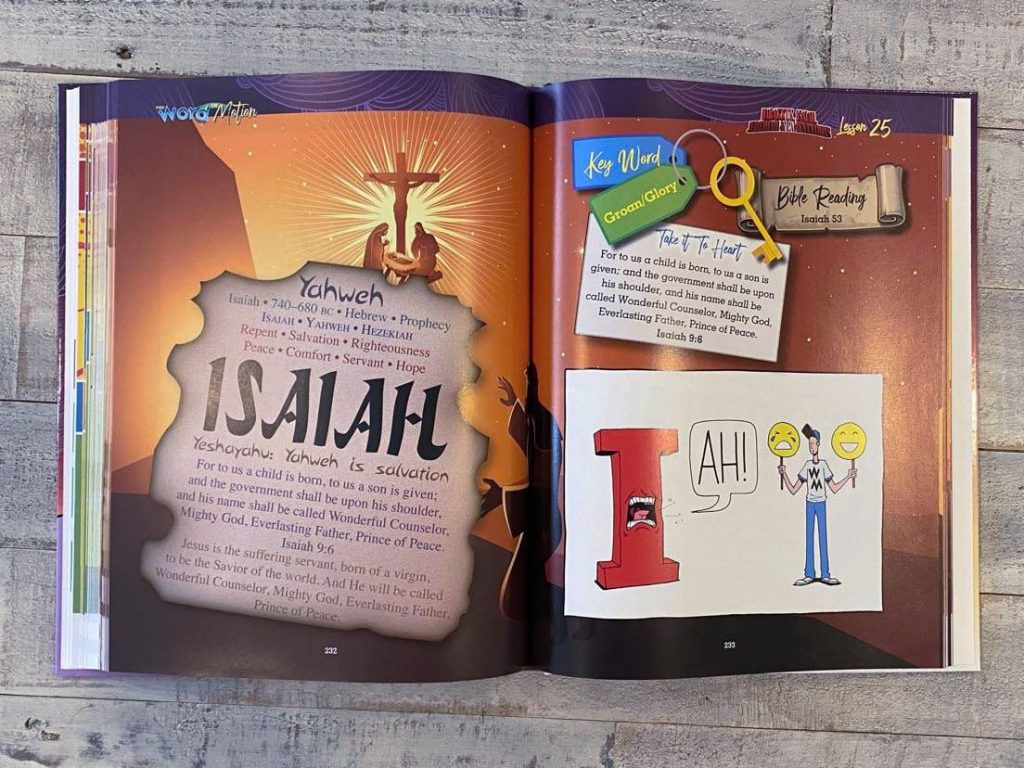
Take It to Heart is the memory verse. This verse goes along with the key theme of the book(s) being studied that week. In the notebooking journal, you’ll find a page for your child to practice writing the memory verse. (Remember, you’ll probably want to get a notebooking journal for each of your children.)
Then it’s time for the Bible Reading. The first 15 lessons are chronological. This is where you’ll find the narrative/story of the book(s) of the Bible in that week’s lesson. In the last 15 lessons, you’ll find the Bible readings that represent key passages from each book being studied.
Sidebar Articles
Sidebar Articles provide you with context and a better understanding of the book(s) of the Bible being studied that week. I think this part is so important! Why? Most of us haven’t spent much time thinking about what it was like to live during Bible times. The culture was so different! These articles help give us some understanding of things we might not otherwise understand very well.
Doctrine
The Doctrine section is next. You’ll find nondenominational doctrine that is historically agreed upon by the church. It includes topics such as the fall of mankind, sin nature, miracles, repentance, redemption, and more.
Character Sketch
Each lesson also includes a Character Sketch section. This is where you’ll find a profile of a Bible character told from that Bible character’s perspective. Some are funny, some are dramatic, and some are sad. I feel like this section is very important! We want our children to understand that these events really happened and these people really lived.
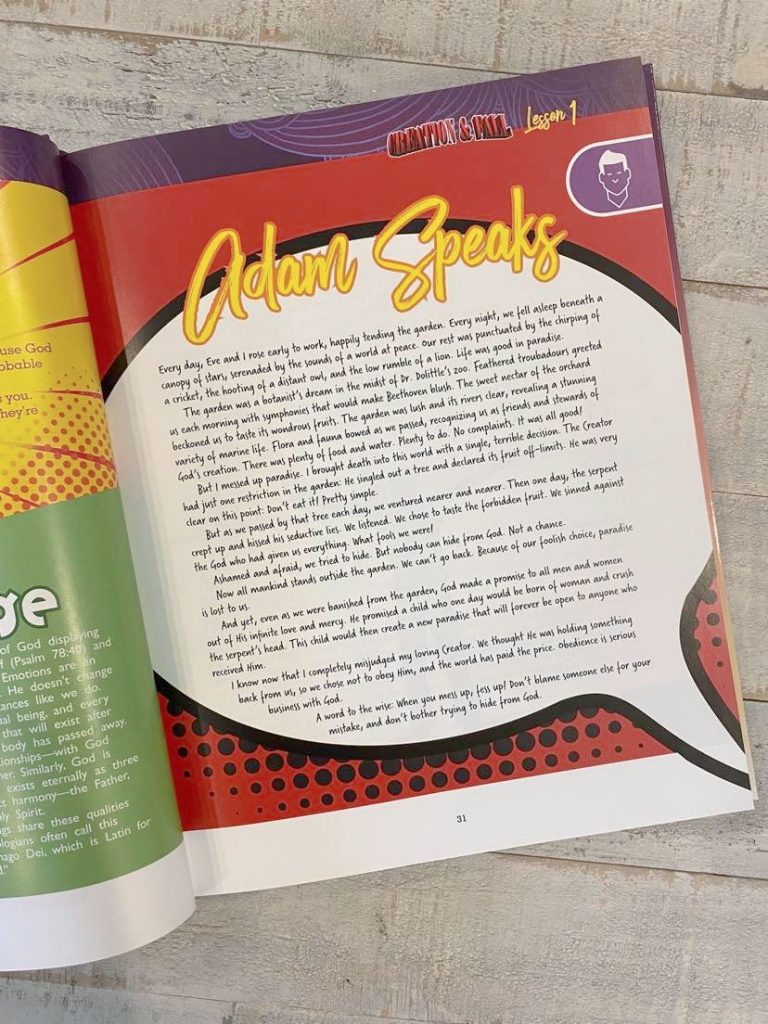
Prayer
The final section of each lesson is a Prayer. The prayer focuses on the theme(s) covered in that lesson. You may want to pray this prayer with your family. And of course, you can also pray your own prayer and encourage your children to pray too!
I know this all sounds like an overwhelming amount of information! I think you’ll find, though, that it’s not overwhelming at all. The information is clear and simple and easy to read and understand.
Summary (and My Opinion) of Apologia’s Homeschool Bible Curriculum
I really do love this homeschool Bible curriculum! It is colorful, hands-on, and full of fun examples and ways to remember information. It also covers so many important topics! I truly believe it all works together to give the whole family a better understanding of the Bible.
I especially like the Sidebar Articles. I personally feel like it’s very important to understand the culture during Bible times. Why? So we can get a better understanding of what it means for us today. I also love the Character Sketches. I think this helps our children to know that these were real people and real events–not just made-up stories).
In short, I’m honestly happy to share this Bible curriculum with you today! This is one of the most important subjects we can share with our children! I believe you’ll find it fun to use, find that your children enjoy it, and learn so much as you study together as a family.
Blessings!









Just FYI, the ” LINK TO GO TO THE GIVEAWAY ON APOLOGIA! ” doesnt work. I tried it multiple times and their page will not let you submit the entry form.
I’m so sorry! This giveaway was done in January of 2022. You probably found it after the giveaway ended.